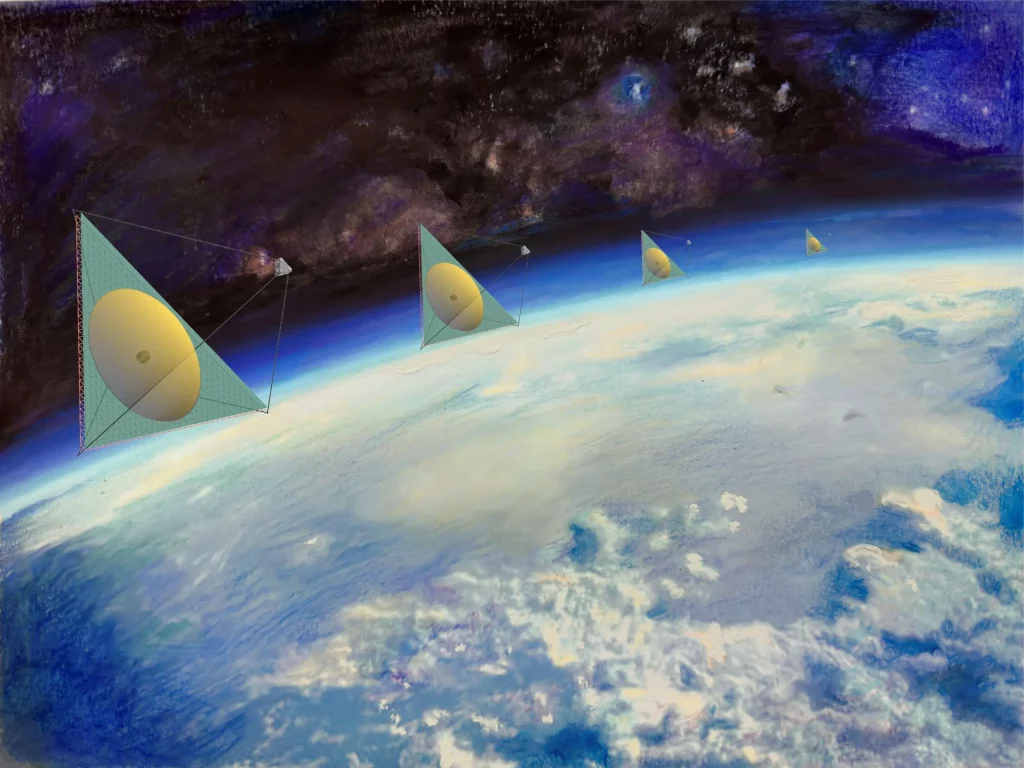Para peneliti telah mengembangkan metode baru untuk membuat cermin teleskopik yang memungkinkan untuk menempatkan teleskop yang jauh lebih besar, dan dengan demikian lebih sensitif, ke orbit. Kredit: Sebastian Rabin, Institut Max Planck untuk Fisika Ekstraterestrial
Kaca spion yang ringan dan fleksibel dapat dilipat rapat saat diluncurkan, lalu dibentuk ulang dengan tepat setelah digunakan.
Para ilmuwan telah mengembangkan metode baru untuk memproduksi dan membentuk cermin besar berkualitas tinggi, yang jauh lebih tipis daripada cermin utama yang biasa digunakan dalam teleskop luar angkasa. Cermin yang dihasilkan ini memiliki fleksibilitas yang cukup untuk dibungkus dan dikemas secara efisien di dalam pesawat ruang angkasa selama peluncuran.
“Meluncurkan dan menggunakan teleskop ruang angkasa adalah prosedur yang rumit dan mahal,” kata Sebastien Rabian dari Max Planck Institute for Extraterrestrial Physics di Jerman. “Pendekatan baru ini—yang sangat berbeda dari produksi cermin biasa dan prosedur pemolesan—dapat membantu memecahkan masalah berat dan pengepakan untuk cermin teleskop, memungkinkan teleskop yang lebih besar, dan karena itu lebih sensitif, ditempatkan di orbit.”

Para peneliti menciptakan cermin dengan menggunakan deposisi uap kimia untuk menumbuhkan cermin film pada cairan yang berputar di dalam ruang vakum. Hal ini memungkinkan mereka membuat film parabola tipis yang dapat digunakan sebagai cermin utama teleskop hanya dengan melapisinya dengan permukaan reflektif seperti aluminium. Kredit: Sebastian Rabin, Institut Max Planck untuk Fisika Ekstraterestrial
Di Majalah Grup Penerbitan Optica optik terapanRabih melaporkan keberhasilan pembuatan prototipe cermin film parabola hingga diameter 30 cm. Cermin-cermin ini, yang dapat ditingkatkan ke ukuran yang diperlukan dalam teleskop luar angkasa, dibuat dengan menggunakan pengendapan uap kimia untuk menumbuhkan cermin membran pada cairan yang berputar di dalam ruang vakum. Dia juga mengembangkan metode yang menggunakan panas untuk memperbaiki kerusakan secara adaptif yang mungkin terjadi setelah pemaparan cermin.
“Meskipun pekerjaan ini hanya menunjukkan kelayakan metode, ini meletakkan dasar untuk sistem cermin besar dan dapat dikemas yang lebih murah,” kata Rabian. “Itu bisa membuat cermin ringan berdiameter 15 atau 20 meter menjadi kenyataan, memungkinkan teleskop ruang angkasa yang besarnya lebih sensitif daripada yang saat ini digunakan atau direncanakan.”
Menerapkan proses lama dengan cara baru
Metode baru dikembangkan selama[{” attribute=””>COVID-19 pandemic, which Rabien says gave him some extra time to think and try out new concepts. “In a long series of tests, we researched many liquids to find out their usability for the process, investigated how the polymer growth can be carried out homogeneously, and worked to optimize the process,” he said.
For chemical vapor deposition, a precursor material is evaporated and thermally split into monomeric molecules. Those molecules deposit on the surfaces in a vacuum chamber and then combine to form a polymer. This process is commonly used to apply coatings such as the ones that make electronics water-resistant, but this is the first time it has been used to create parabolic membrane mirrors with the optical qualities necessary for use in telescopes.

Membrane mirrors made using the new technique are flexible enough to be rolled up. This could be helpful for storing the mirrors inside of a launch vehicle. Credit: Sebastian Rabien, Max Planck Institute for Extraterrestrial Physics
To create the precise shape necessary for a telescope mirror, the researchers added a rotating container filled with a small amount of liquid to the inside of the vacuum chamber. The liquid forms a perfect parabolic shape onto which the polymer can grow, forming the mirror base. When the polymer is thick enough, a reflective metal layer is applied to the top via evaporation and the liquid is washed away.
“It has long been known that rotating liquids that are aligned with the local gravitational axis will naturally form a paraboloid surface shape,” said Rabien. “Utilizing this basic physics phenomenon, we deposited a polymer onto this perfect optical surface, which formed a parabolic thin membrane that can be used as the primary mirror of a telescope once coated with a reflecting surface such as aluminum.”
Although other groups have created thin membranes for similar purposes, these mirrors are typically shaped using a high-quality optical mold. Using a liquid to form the shape is much more affordable and can be more easily scaled up to large sizes.
Reshaping a folded mirror
The thin and lightweight mirror created using this technique can easily be folded or rolled up during the trip to space. However, it would be nearly impossible to get it back to the perfect parabolic shape after unpacking. To reshape the membrane mirror, the researchers developed a thermal method that uses a localized temperature change created with light to enable adaptive shape control that can bring the thin membrane into the desired optical shape.
The researchers tested their approach by creating 30-cm diameter membrane mirrors in a vacuum deposition chamber. After much trial and error, they were able to produce high-quality mirrors with a surface shape suitable for telescopes. They also showed that their thermal radiative adaptive shaping method worked well, as demonstrated with an array of radiators and illumination from a digital light projector.
The new membrane-based mirrors could also be used in adaptive optics systems. Adaptive optics can improve the performance of optical systems by using a deformable mirror to compensate for distortion in incoming light. Because the surface of the new membrane mirrors is deformable, these mirrors could be shaped with electrostatic actuators to create deformable mirrors that are less expensive to make than those created with conventional methods.
Next, the researchers plan to apply more sophisticated adaptive control to study how well the final surface can be shaped and how much of an initial distortion can be tolerated. They also plan to create a meter-sized deposition chamber to better study the surface structure and packaging and unfolding processes for a large-scale primary mirror.
Reference: “Adaptive parabolic membrane mirrors for large deployable space telescopes” by Sebastian Rabien, 4 April 2023, Applied Optics.
DOI: 10.1364/AO.487262

“Kutu buku musik lepas. Pecandu internet bersertifikat. Pencinta perjalanan. Penyelenggara hardcore. “








More Stories
Rumah sakit Colorado dituduh kontaminasi karena peralatan | kesehatan
Penemuan sisa-sisa virus raksasa purba memberikan petunjuk baru tentang asal usul kehidupan kompleks
Para ilmuwan menemukan “oksigen gelap” yang dihasilkan tanpa cahaya di kedalaman lautan